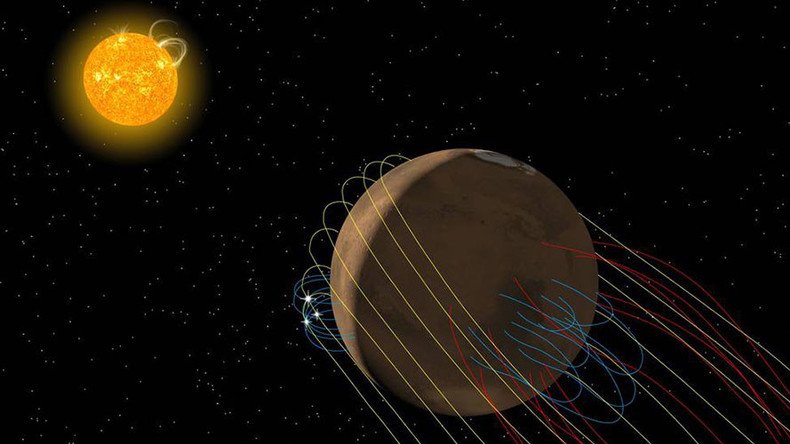NASA exploring whether a ‘magnetic tail’ is destroying Martian atmosphere

Plasma explosions from the sun over billions of years have all but stripped Mars of its atmosphere. But a new discovery by NASA shows that remnants of the Red Planet’s magnetic field can be found in the form of a rotating ‘tail’.
Invisible to the naked eye, the so-called ‘magnetotail’ was recently detected by NASA’s Mars Atmosphere and Volatile Evolution Mission spacecraft (MAVEN).
MAVEN was launched in 2013 to trace the Martian world’s climate history and determine if it may have once sustained life.
READ MORE: Sun explosions & space hurricanes: The silent threat to global communications systems
The ‘tail’ phenomenon is caused by solar winds whipping over the surface of the planet, resulting in the remaining pockets of Mars’ once-protective magnetic field joining with sun plasma particles.
The process can cause magnetic forces to be twisted by the 1.6 million kph solar winds, said Gina DiBraccio, of NASA’s Goddard Space Flight Center. It may also be contributing to the destruction of Mars’ thin atmosphere, allowing gases to escape into space.
Key points: #MAVEN is seeing previously unobserved magnetic field variations in the #Martian magnetotail due to magnetic reconnection. (1/2)
— NASA's MAVEN Mission (@MAVEN2Mars) October 19, 2017
“We found that Mars’ magnetic tail, or magnetotail, is unique in the solar system,” DiBraccio said.
“Our model predicted that magnetic reconnection will cause the Martian magnetotail to twist 45 degrees from what’s expected based on the direction of the magnetic field carried by the solar wind.”
READ MORE: Astronaut completes essential ISS repairs despite worn-out tether & faulty jetpack
The “unique” magnetic field movement was measured and mapped using the MAVEN spacecraft’s magnetometer. Over the next couple of years, NASA plans to explore exactly how significant the impact of magnetic movement is to the Red Planet’s atmospheric loss.













